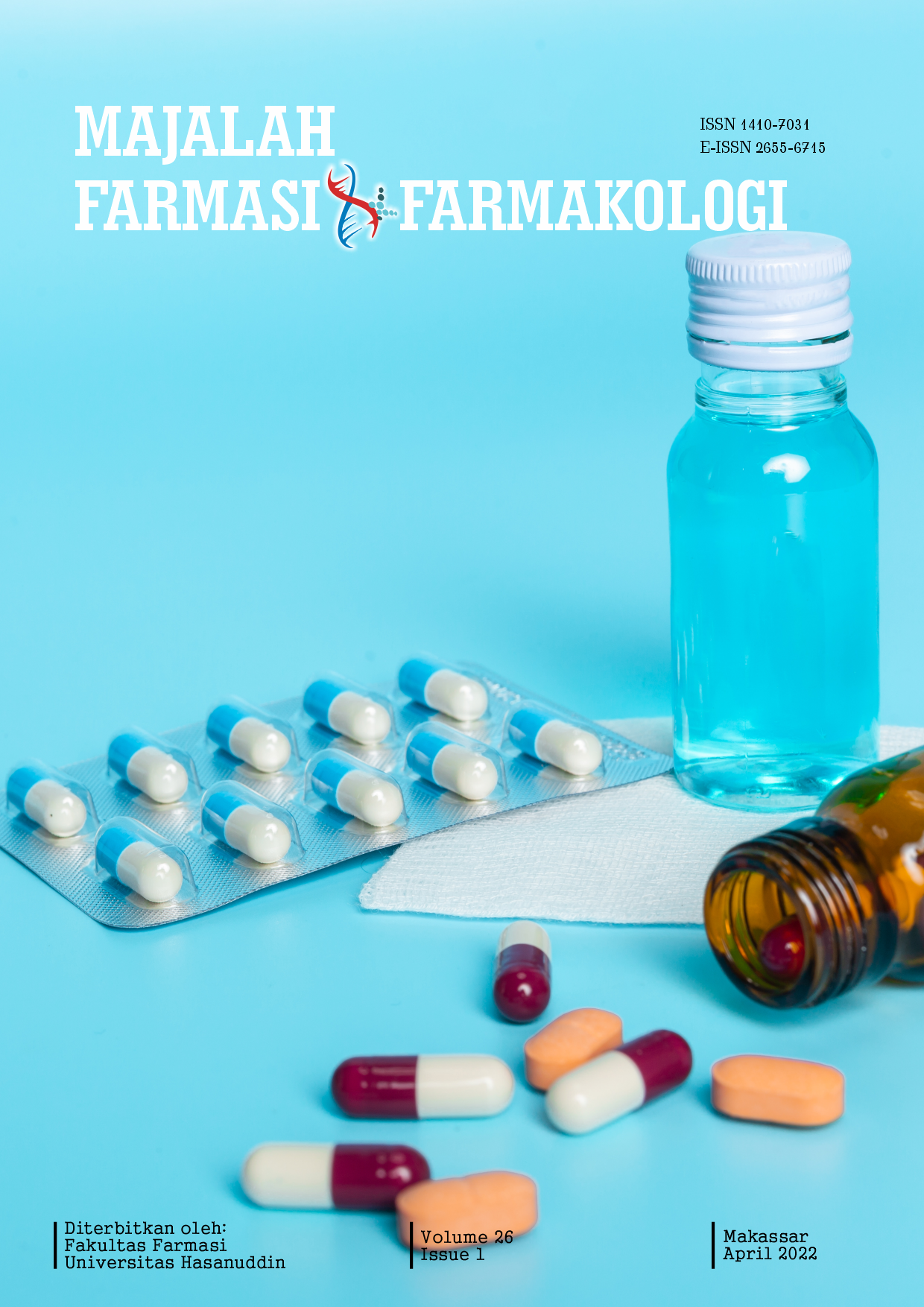EVALUASI PENGGUNAAN TERAPI ANTIBIOTIK EMPIRIS TERHADAP LUARAN KLINIS PASIEN PNEUMONIA KOMUNITAS RAWAT INAP
Keywords:
Antibiotik empiris, Pneumonia komunitas, ATC/DDD, Metode Gyssens, Antibiotik empiris, pneumonia komunitas, ATC/DDD, metode Gyssens.Abstract
Pneumonia komunitas merupakan penyakit infeksi pada parenkim paru-paru yang mengancam jiwa sehingga dapat diberikan terapi antibiotik empiris. Penelitian ini bertujuan mengetahui nilai DDD dan kualitas penggunaan terapi antibiotik empiris menggunakan metode Gyssens pada pasien pneumonia komunitas rawat inap serta hubungannya terhadap luaran klinis pasien di RSUD Kota Makassar. Penelitian ini bersifat observasional dengan pengambilan data dilakukan secara retrospektif dari rekam medis pasien usia >19 tahun yang memenuhi kriteria inklusi periode Januari 2018-Desember 2019. Dikumpulkan data karakterisik pasien, pengobatan dan luaran klinis pasien setelah pemberian antibiotik. Analisis data dilakukan secara deskriptif dan dilanjutkan uji Chi square untuk menganalisis hubungan penggunaan antibiotik dengan luaran klinis pasien. Karakteristik pasien yang beresiko yaitu usia, jenis kelamin, jumlah obat dan komorbid turut dianalisis. Hasil evaluasi kuantitatif antibiotik bahwa seftriakson memiliki DDD tertinggi yaitu 44,9 DDD/100 patient-days, pada evaluasi kualitatif dari 74 sampel sebanyak 14 pasien (18,9%) memenuhi kategori ketepatan pemberian antibiotik (kategori 0) dan ketidaktepatan pemberian antibiotik pada kategori IVa sebanyak 50 pasien (67,6%), kategori IVb sebanyak 9 pasien (12,2%) dan kategori IIa sebanyak 1 pasien (1,4%). Uji chi-square menunjukkan tidak ada hubungan bermakna antara jumlah dan ketepatan penggunaan terapi antibiotik empiris terhadap luaran klinis pasien pneumonia komunitas pada periode Januari 2018-Desember 2019. Pasien yang memiliki komorbid baik yang berkategori infeksi maupun kategori infeksi dan non infeksi merupakan faktor resiko yang memiliki hubungan yang bermakna dengan luaran klinis pasien pada periode tersebut.
References
Perhimpunan Dokter Paru Indoneisa. Pneumonia Komunitas : Pedoman Diagnosis & Penalataksanaan Di Indonesia. 2014. 5–52 p.
2. Prina E, Ranzani OT, Torres A. Community-acquired pneumonia. Lancet [Internet]. 2015;386(9998):1097–108. Available from: http://dx.doi.org/10.1016/S0140-6736(15)60733-4
3. Ramirez JA, Wiemken TL, Peyrani P, Arnold FW, Kelley R, Mattingly WA, et al. Adults Hospitalized with Pneumonia in the United States: Incidence, Epidemiology, and Mortality. Clin Infect Dis. 2017;65(11):1806–12. https://doi.org/10.1093/cid/cix647
4. Wunderink RG. Community-acquired pneumonia [Internet]. Fourth Edi. Vol. 1; 2017. 251-257.e1 p. https://doi.org/10.1016/B978-0-7020-6285-8.00028-99
5. Cilloniz C, Martin-Loeches I, Garcia-Vidal C, Jose AS, Torres A. Microbial etiology of pneumonia: Epidemiology, diagnosis and resistance patterns. Int J Mol Sci. 2016;17(12).
6. Kementerian Kesehatan RI. Laporan Riskesdas 2018. Lap Nas Riskesdas 2018 [Internet]. 2018;53(9):154–65. Available from: http://www.yankes.kemkes.go.id/assets/downloads/PMK No. 57 Tahun 2013 tentang PTRM.pdf
7. Brown JS. Community-acquired pneumonia. Clin Med J R Coll Physicians London. 2012;12(6):538–43. https://doi.org/10.7861/clinmedicine.12-6-538
8. Ferreira-Coimbra J, Sarda C, Rello J. Burden of Community-Acquired Pneumonia and Unmet Clinical Needs. Adv Ther. 2020;37(4):1302–18. https://doi.org/10.1007/s12325-020-01248-7
9. Kementerian Kesehatan RI. Peraturan Menteri Kesehatan RI Nomor 28 tahun 2021 tentang Pedoman Penggunaan Antibiotik. Jdih.Kemkes.Go.Id. 2021;1–97.
10. Metlay JP, Waterer GW, Long AC, Anzueto A, Brozek J, Crothers K, et al. Diagnosis and treatment of adults with community-acquired pneumonia. Am J Respir Crit Care Med. 2019;200(7):E45–67. https://doi.org/10.1164/rccm.201908-1581ST
11. Zaman S Bin, Hussain MA, Nye R, Mehta V, Mamun KT, Hossain N. A Review on Antibiotic Resistance: Alarm Bells are Ringing. Cureus. 2017;9(6). https://doi.org/10.7759/cureus.1403
12. World Health Organization. WHO Methodology for Point Prevalence Survey on Antibiotic Use in Hospitals. World Heal Organ [Internet]. 2018;1–102. Available from: https://www.who.int/medicines/access/antimicrobial_resistance/WHO-EMP-IAU-2018_01/en/
13. Kementrian Kesehatan Republik Indonesia. Pedoman Pelayanan Kefarmasian Untuk Terapi Antibiotika Kementrian Kesehatan Republik Indonesia. 2011;
14. WHO. WHO methodology for a global programme on surveillance of antimicrobial consumption. World Heal Organ https//http//www who int/medicines/areas/rational_use/WHO_AMCsurveillance_1 0 pdf. 2016;1–44.
15. Gyssens IC. Audits for monitoring the quality of antimicrobial prescriptions. Antibiot Policies Theory Pract. 2005;(Table 1):197–226. https://doi.org/10.1007/0-387-22852-7_12
16. Ambami S. Evaluasi Penggunaan Antibiotik dengan Metode ATC/DDD Pada Pasien Pneumonia di RSUD Jombang Periode Januari-Desember 2019. UIN Maulana Malik Ibrahim. 2020;(1):1–91.
17. Ilmi T, Restyana A, Kadir MBA, Yuniarto PF. Profile of Antibiotic Use and Germ Map in Pneumonia Patients in Pulmonary Space (Case Study at RSUD dr. Iskak. Tulungagung). J Phys Conf Ser. 2020;1569(3). https://doi.org/10.1088/1742-6596/1569/3/032064
18. Dorj G, Salvesen Blix H, Sunderland B, Gankhulug B, Tegshee O, Purevkhuu M, et al. Antibiotic Utilization Trends in Two State Hospitals of Mongolia from 2013 to 2017. Biomed Res Int. 2019;2019. https://doi.org/10.1155/2019/9160296
19. Bozkurt F, Kaya S, Tekin R, Gulsun S, Deveci O, Dayan S, et al. Analysis of antimicrobial consumption and cost in a teaching hospital. J Infect Public Health. 2014;7(2):161–9. https://doi.org/10.1016/j.jiph.2013.09.007.
20. Keita M, Traore F, Camara M, Camara A, Sandouno S, Hees T. The use of antibiotics in the university hospitals of Conakry: evaluation of the consumption and the analysis of determinants. Int J Community Med Public Heal. 2016;(January):1547–53.
21. Rawls SM. Antibiotics, β-Lactam. Encycl Neurol Sci. 2014;1:207–9. https://doi.org/10.1016/B978-0-12-385157-4.00250-5.
22. Mandell LA, Wunderink RG, Anzueto A, Bartlett JG, Campbell GD, Dean NC, et al. Infectious Diseases Society of America/American Thoracic Society Consensus Guidelines on the management of community-acquired pneumonia in adults. Clin Infect Dis. 2007;44(SUPPL. 2). https://doi.org/10.1086/511159
23. Scholar E. Ceftriaxone. xPharm: The Comprehensive Pharmacology Reference . 2007. https://doi.org/10.1016/B978-008055232-3.61412-6
24. Shirin M, Shahidul Islam M. Ceftriaxone, an Empirical Goldmine: A Systematic Review of Randomized Controlled Trials. Mathews J Pharm Sci. 2020;4(1):1–5. https://doi.org/10.30654/mjps.10001
25. Lai CC, Wang CY, Chu CC, Tan CK, Lu CL, Lee YC, et al. Correlation between antibiotic consumption and resistance of Gram-negative bacteria causing healthcare-associated infections at a university hospital in Taiwan from 2000 to 2009. J Antimicrob Chemother. 2011;66(6):1374–82. https://doi.org/10.1093/jac/dkr103
26. Goossens H. Antibiotic consumption and link to resistance. Clin Microbiol Infect [Internet]. 2009;15(SUPPL. 3):12–5. Available from: http://dx.doi.org/10.1111/j.1469-0691.2009.02725.x
27. Joseph NM, Bhanupriya B, Shewade DG, Harish BN. Relationship between antimicrobial consumption and the incidence of antimicrobial resistance in Escherichia coli and Klebsiella pneumoniae isolates. J Clin Diagnostic Res. 2015;9(2):DC08-DC12. https://doi.org/10.7860/JCDR/2015/11029.5537
28. Kollef MH, Vlasnik J, Sharpless L, Pasque C, Murphy D, Fraser V. Scheduled change of antibiotic classes a strategy to decrease the incidence of ventilator-associated pneumonia. Am J Respir Crit Care Med. 1997;156(4 PART I):1040–8. https://doi.org/10.1164/ajrccm.156.4.9701046
29. Abel zur Wiesch P, Kouyos R, Abel S, Viechtbauer W, Bonhoeffer S. Cycling Empirical Antibiotic Therapy in Hospitals: Meta-Analysis and Models. PLoS Pathog. 2014;10(6). https://doi.org/10.1371/journal.ppat.1004225
30. Eljaaly K, Alshehri S, Aljabri A, Abraham I, Al Mohajer M, Kalil AC, et al. Clinical failure with and without empiric atypical bacteria coverage in hospitalized adults with community-acquired pneumonia: A systematic review and meta-analysis. BMC Infect Dis. 2017;17(1):1–7. https://doi.org/10.1186/s12879-017-2495-5
31. Caballero J, Rello J. Combination antibiotic therapy for community-acquired pneumonia. Ann Intensive Care. 2011;1(1):1–7. https://doi.org/10.1186/2110-5820-1-48
32. Gilman GA. Dasar Farmakologi Terapi, Edisi 10, Volume 3,. Terjemahan Tim Alih Bahasa Sekolah Farmasi ITB. 2012. Jakarta: Penerbit Buku Kedokteran EGC
33. Sandeep Nayar1, Ashfaq Hasan2, Pradyut Waghray3, Srinivasan Ramananthan4 JA, Jain5 R. Management of community‑acquired bacterial pneumonia in adults: Limitations of current antibiotics and future therapies. Lung India. 2019;36(6):525–33. https://doi.org/DOI: 10.4103/lungindia.lungindia_38_19
34. Onufrak NJ, Forrest A, Gonzalez D. Pharmacokinetic and Pharmacodynamic Principles of Anti-infective Dosing. Clin Ther [Internet]. 2016;38(9):1930–47. Available from: http://dx.doi.org/10.1016/j.clinthera.2016.06.015
35. Jamal JA, Abdul-Aziz MH, Lipman J, Roberts JA. Defining antibiotic dosing in lung infections. Clin Pulm Med. 2013;20(3):121–8. https://doi.org/10.1097/CPM.0b013e31828fc646
36. Martinez FJ. Monotherapy versus dual therapy for community-acquired pneumonia in hospitalized patients. Clin Infect Dis. 2004;38(SUPPL. 4). https://doi.org/10.1086/382689
37. File TM. No Title [Internet]. Treatment of community-acquired pneumonia in adults in the outpatient setting. 2020. Available from: https://www.uptodate.com/contents/treatment-of-community-acquired-pneumonia-in-adults-who-require-hospitalization?source=related_link
38. Zhang YQ, Zou SL, Zhao H, Zhang MM, Han CL. Ceftriaxone combination therapy versus respiratory fluoroquinolone monotherapy for community-acquired pneumonia: A meta-analysis. Am J Emerg Med [Internet]. 2018;36(10):1759–65. Available from: https://doi.org/10.1016/j.ajem.2018.01.079
39. Patil S, Mane R. Comparison of efficacy of levofloxacin-metronidazole combination versus ceftriaxone in cases of moderate diabetic foot infection. Int J Basic Clin Pharmacol. 2016;5(5):1775–9. https://doi.org/10.18203/2319-2003.ijbcp20163145
40. Stein GE, Goldstein EJC. Fluoroquinolones and anaerobes. Clin Infect Dis. 2006;42(11):1598–607. https://doi.org/10.1086/503907
41. Lexicomp. Levofloxacin (Systemic). Diakses 16/10/2020 jam 23.48 WITA
42. Noel GJ. A Review of Levofloxacin for the Treatment of Bacterial Infections. Clin Med Ther. 2009;1:CMT.S28. https://doi.org/10.4137/cmt.s28
43. Rivkin AM. Hepatocellular enzyme elevations in a patient receiving ceftriaxone. Am J Heal Pharm. 2005;62(19):2006–10. https://doi.org/10.2146/ajhp040452
44. Robles M, Toscano E, Cotta J, Isabel Lucena M, J. Andrade R. Antibiotic-Induced Liver Toxicity: Mechanisms, Clinical Features and Causality Assessment. Curr Drug Saf. 2010;5(3):212–22. https://doi.org/10.2174/157488610791698307.
45. Ulldemolins M, Roberts JA, Rello J, Paterson DL, Lipman J. The effects of hypoalbuminaemia on optimizing antibacterial dosing in critically ill patients. Clin Pharmacokinet. 2011;50(2):99–110. https://doi.org/10.2165/11539220-000000000-00000
46. Setiawan E, Widyati, Marpaung FR, Sukandar E, Susaniwati, Lukas DL, et al. Narrative Study on Pharmacokinetics of Antibiotics among Critically Ill Patients: the Implication on the Pharmacokinetics-Pharmacodynamics Target Attainment. Pharm Sci Res. 2019;6(1):1–12. https://doi.org/10.7454/psr.v6i1.4274
47. Munar MY, Singh H.Drug Dosing Adjustment in Patients with Chronic Kidney Disease. American Family Physician. 2007;75(10):1488–1496.
48. AHFS.LevoFLOXacin (Systemic) Monograph for Professionals - Drugs. com
49. Humaida R. Strategy to Handle Resistance of Antibiotics. Strateg To Handle Resist Antibiot J Major [Internet]. 2014;3(7):113–20. Available from: http://juke.kedokteran.unila.ac.id/index.php/majority/article/view/487%0Ahttp://juke.kedokteran.unila.ac.id/index.php/majority/article/view/487/488
50. Perhimpunan Dokter Paru Indonesia. Pneumonia komuniti 1973 - 2003. Pneumonia Komuniti (Pedoman diagnosis dan penatalaksanaan). 2003;6.
51. Rumende CM, Chen LK, Karuniawat A, Bratanata J, Falasiva R, Sitorus TP, et al. Hubungan Antara Ketepatan Pemberian Antibiotik Berdasarkan Alur Gyssens dengan Perbaikan Klinis Pasien pada Pneumonia Komunitas. J Penyakit Dalam Indones. 2019;6(2):71. https://doi.org/10.7454/jpdi.v6i2.335
52. Setiadi F. Analisis Faktor-Faktor Yang Mempengaruhi Outcome Terapi Pasien Pneumonia Di Rumah Sakit Umum Pusat Fatmawati Jakarta. 2019;5(3):18–28.
53. Peyrani P, Arnold FW, Bordon J, Furmanek S, Luna CM, Cavallazzi R, et al. Incidence and Mortality of Adults Hospitalized With Community-Acquired Pneumonia According to Clinical Course. Chest [Internet]. 2020;157(1):34–41. Available from: https://doi.org/10.1016/j.chest.2019.09.022
54. Tokgoz Akyil F, Yalcinsoy M, Hazar A, Cilli A, Celenk B, Kilic O, et al. Prognosis of hospitalized patients with community-acquired pneumonia. Rev Port Pneumol (English Ed [Internet]. 2018;24(3):164–9. Available from: http://dx.doi.org/10.1016/j.rppnen.2017.07.010
55. Nguyen MTN, Saito N, Wagatsuma Y. The effect of comorbidities for the prognosis of community-acquired pneumonia: An epidemiologic study using a hospital surveillance in Japan. BMC Res Notes [Internet]. 2019;12(1):1–5. Available from: https://doi.org/10.1186/s13104-019-4848-1
Downloads
Published
Issue
Section
License
Copyright (c) 2022 Majalah Farmasi dan Farmakologi

This work is licensed under a Creative Commons Attribution-NonCommercial 4.0 International License.
The copyright to this article is transferred to Universitas Hasanuddin (UNHAS) if and when the article is accepted for publication. The undersigned hereby transfers all rights in and to the paper including without limitation all copyrights to UNHAS. The undersigned hereby represents and warrants that the paper is original and that he/she is the author of the paper, except for material that is clearly identified as to its original source, with permission notices from the copyright owners where required. The undersigned represents that he/she has the power and authority to make and execute this assignment.
We declare that:
- This paper has not been published in the same form elsewhere.
- It will not be submitted anywhere else for publication prior to acceptance/rejection by this Journal.
- A copyright permission is obtained for materials published elsewhere and which require this permission for reproduction.
Furthermore, I/We hereby transfer the unlimited rights of publication of the above-mentioned paper in whole to UNHAS The copyright transfer covers the exclusive right to reproduce and distribute the article, including reprints, translations, photographic reproductions, microform, electronic form (offline, online) or any other reproductions of similar nature.
The corresponding author signs for and accepts responsibility for releasing this material on behalf of any and all co-authors. This agreement is to be signed by at least one of the authors who have obtained the assent of the co-author(s) where applicable. After submission of this agreement signed by the corresponding author, changes of authorship or in the order of the authors listed will not be accepted.


